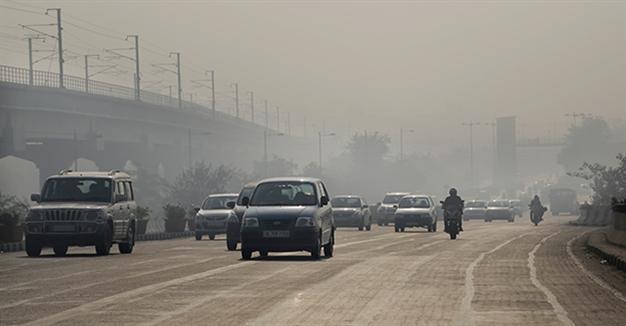India’s smog-shrouded capital pulls cars off roads
NEW DELHI - Agence France-Presse

Vehicles move through morning smog on the first day of a two-week experiment to reduce the number of cars to fight pollution in New Delhi, India, Friday, Jan. 1, 2016. AP Photo
More than a million private cars were banned from New Delhi’s roads on Jan. 1, as authorities began testing drastic new measures to cut smog in the world’s most polluted capital.
For 15 days from Jan. 1, private cars will only be allowed on the city’s roads every other day to try to reduce pollutant levels, which regularly hit 10 times the World Health Organization’s safe limits.
Cars with odd-numbered license plates will be allowed on the roads on odd-numbered dates, and those with even-numbered plates on the other days.
As the restrictions came into force on Jan. 1 morning, overall pollutant levels hit a “hazardous” 429 on the U.S. embassy’s air quality index, meaning everyone is at risk of respiratory problems and children and older people should stay indoors.
Hundreds of traffic police and volunteers took to the streets to enforce the scheme, including dozens of children wearing smog masks and holding banners urging drivers to comply.
Most drivers appeared to be sticking to the rules Friday, with Delhi’s usually clogged roads flowing relatively freely.
“Delhi has done it!” tweeted the city’s Chief Minister Arvind Kejriwal, who said he was carpooling with colleagues to get to work.
“Reports so far encouraging,” he added.
One early violator caught driving a car with an even-numbered license plate on a busy stretch of road was fined 2,000 rupees ($30) and ordered to return home.
“I would have expected to catch at least dozens in the first half an hour, but surprisingly most people are obeying,” said Ankit Kumar, a traffic policeman.
The restrictions, which run until January 15 on a trial basis, are part of a wider drive aimed at cutting pollution that also includes shutting some coal-fired power plants and vacuuming roads to reduce dust.
Schools have been ordered to remain closed for the period so that their buses can be used to ferry commuters to work.
The Delhi government says the measures could be introduced on a more permanent basis if successful, although some believe residents could try to get around the restrictions by forging number plates or buying second cars.
The scheme will be truly tested next week, when millions of commuters will have to find alternative ways to get to work after the long New Year weekend.
In the evening, the Delhi government claimed the car rationing order was successful and praised residents for supporting it.
“The response is beyond expectations,” Satyendar Kumar Jain, a local government minister, told reporters, adding that just one percent of drivers had broken the rules.
Willingness in using public transportation
Many residents AFP spoke to said they were willing to do their part.
“We are ready to travel in public transportation as long as there aren’t any hassles,” said Pallavi Agarwal, a 37-year-old doctor, as she stepped out of her SUV with her four-year-old son and husband.
“Pollution is a real health concern and we have to do something.”
Yet critics say the restrictions do not go far enough, with motorcyclists and women driving alone exempt. Campaigners say motorbikes create up to 31 percent of pollution from vehicles.
Others remain skeptical that drivers will observe the restrictions for long.
“Just wait for Jan. 4, people are going to be back to their old habits. Delhiites are too used to their cars,” said Kirti Lal, who commutes by bus.
A 2014 WHO survey of more than 1,600 cities ranked Delhi as the most polluted, partly because of the 8.5 million vehicles on its roads.
Car sales are soaring as incomes rise, with 1,400 extra vehicles pouring onto the city’s already crowded roads every day. India’s capital has been shrouded in a toxic blanket of smog in recent weeks as cooler temperatures trap pollutants in the atmosphere, pushing harmful PM 2.5 levels sky-high.
